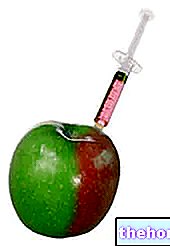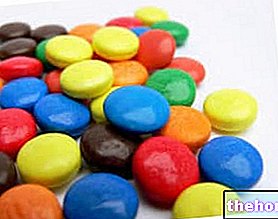Aluminum in Food
Aluminum is a metallic element that makes up about 8.2% of the earth's crust.
In the 19th century, the discovery of cheaper extraction processes (from aluminum oxide and bauxite) enhanced the application and versatility of the material.

However, unlike other metallic elements (such as iron, zinc, copper, etc.), aluminum is neither useful nor essential for man. This is why its excessive presence in the diet must be considered potentially harmful to health.
Aluminum in Additives
Being a ubiquitous element, aluminum is found in the soil and waters around the globe. This means that most foods contain it “at least”, making it enter the human body every day.
We specify immediately that small amounts of aluminum do not cause any type of injury but, over time, this metal could accumulate in the tissues.
Aluminum is a fundamental element for certain food additives, contained above all: in chemical yeast, in melted cheeses (slices, small cheese, etc.) and in pickles.
The table below summarizes the Italian and American list of food additives that contain aluminum.
Additives Licensed in the USA
In Italy, the Ministry of Health considers the following food additives to be safe:
- E520 Aluminum sulphate
- E521 Sodium aluminum sulphate
- E522 Aluminum potassium sulphate
- E523 Aluminum ammonium sulphate
- E541 Sodium aluminum acid phosphate
- E554 Sodium aluminum silicate
- E555 Silicate of potassium and aluminum
- E556 Calcium and aluminum silicate
- E559 Aluminum silicate
In the United States, the Food and Drug Administration (FDA) considers the following food additives generally safe (GRAS):
- Aluminum sulphate
- Aluminum and ammonium sulphate
- Sodium aluminum sulphate
- Calcium and aluminum silicate
- Aluminum stearate
- Sodium and aluminum acid phosphate
- Aluminum nicotinate
The safety of these ingredients is still under discussion.
In September 2005, a research group known as "Department of the Planet Earth"Submitted a request for the exclusion of aluminum-containing additives from the list of GRAS (Generally Recognized As Safe, or generally recognized as safe).
In support of the petition, some studies were reported that attempted to show a correlation between aluminum and Alzheimer's disease.
However, these insights did not prove statistically significant.
Aluminum and Food Preparation
In addition to being naturally present in foods and beverages, and structuring various additives, aluminum can contaminate foods during their preparation. The transit of the material takes place from the utensils (pans, containers, etc.) to the food, through the wear of chemical or physical type.
In the culinary sector, aluminum is one of the most used materials. It is characterized by an excellent thermal conduction, typified by uniformity and effectiveness.
On the other hand, aluminum is a fairly soft metal; if scraped, it easily releases small fragments that “dirty” the food. An indicative example is the production of creams and bechamel; these recipes require a massive use of the whisk which, if made of steel (harder than aluminum), corrodes the pan. Sometimes, the particles that are released by this process are so abundant as to change the color of the sauce or cream making it turn green or gray.
Furthermore, aluminum tends to react with acidic foods such as fruit, vegetables, vinegar, and wine (especially in the presence of heat). This chemical interaction favors the erosion of the metal and promotes its passage into food. Furthermore, aluminum promotes the oxidation of food, which is why it is NOT particularly suitable for preservation.
To avoid these eventualities, many manufacturers have started building pots and pans in anodized aluminum. This process allows you to:
- Maintain the conductivity of the material
- Create a harder surface layer
- Preventing the food reaction.
It is however necessary to avoid scratching the containers, for example by using less aggressive ladles, pliers and whips (for example those made of plastic or silicone coated).
Toxicity of Aluminum
According to some laboratory analyzes carried out in the United States, the foods that contribute most to aluminum intake are: cereals and derivatives (such as bread, sweets, biscuits and pastries), vegetables (spinach, horseradish and lettuce), mushrooms, drinks (tea and cocoa) and some products of early childhood. Drinking water and medicines are also a significant source of aluminum.
Based on some research, considering the poor elimination of metal from fabrics, the "European Food Safety Authority"(EFSA) has restricted the" dietary intake of aluminum to 1mg / kg of body weight per week. Beyond this limit it is not excluded that it can create health problems.
The average dietary exposure of the European population is calculated taking into consideration the studies carried out in different countries (the Netherlands, France, United Kingdom and Sweden). The study, carried out by a group of experts appointed by EFSA, highlighted how heterogeneous the collective exposure can be. The average for the adult population is between 0.2-1.5mg / kg weekly; for younger subjects, the maximum limits varied between 0.7-2.3mg / kg per week.
New York University Langone Medical Center reports that prolonged exposure, especially at high levels, can cause serious health problems.
By eating foods that contain sodium and aluminum acid phosphate, or living near mining mines, exposure to the metal becomes more harmful over time.
However, even short-term exposure such as breathing in aluminum dust in the workplace can be very harmful.
The toxicity of aluminum affects the musculoskeletal system and the brain, causing: muscle weakness, bone pain, osteoporosis, fetal changes, growth retardation in children and impaired male reproductive function (impairment of the testicles). Impairment of abilities mental disorders, dementia and convulsions occur mainly in individuals with renal insufficiency.




























